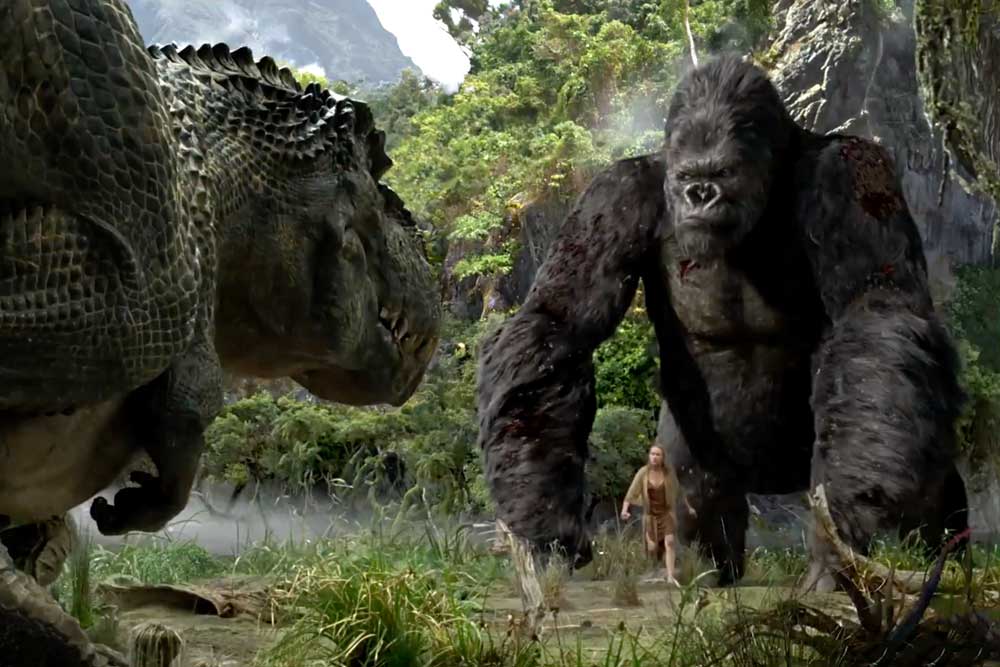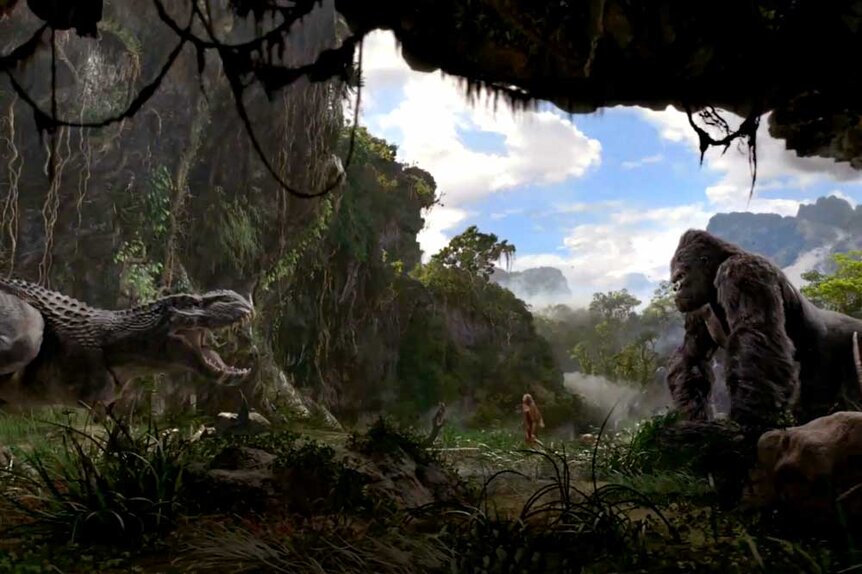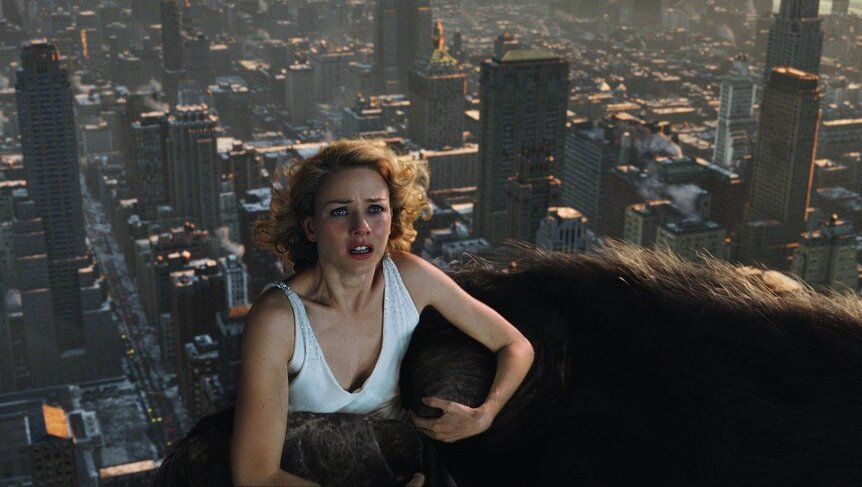Create a free profile to get unlimited access to exclusive videos, sweepstakes, and more!
The Real Reason Kong Is Alone: The Science Behind King Kong
Good things never last, Mr. Denham.

Director Peter Jackson was trying to get a Kong movie made as early as 1995, but it wasn’t the right time. Instead, Jackson focused his efforts on creating the greatest fantasy adaptation of all time in his Lord of the Rings trilogy. Following the worldwide critical and commercial success of those movies, Jackson finally got a crack at Skull Island in his 2005 adaptation of King Kong, now streaming on Peacock.
The movie takes place in 1933, beneath the competing influences of the Great Depression and advancing technologies. It was a world in which you might discover a hidden island filled with creatures both familiar and awe inspiring. Down on his luck filmmaker Carl Denhem (Jack Black) and vaudeville actor Ann Darrow (Naomi Watts) join forces to make the greatest movie of all time on a mysterious claw-shaped island.
THE LONELINESS OF KING KONG
The particulars of Kong, including his size and origin, vary from movie to movie, but in every single telling he is alone. The reasons for his solitude haven’t been widely explored, but the 2005 movie shows the decaying skeletons of other giant apes, long since dead. While their cause of death isn’t entirely clear, it’s implied that the rest of Kong’s family were killed off by the other large predators on the island, particularly the T. rex-like theropod dinosaurs.
RELATED: Peter Jackson’s 'King Kong' Remains An Underrated Wonder Of The World
The dinosaurs probably contributed to the demise of Kong’s species, but the true culprit may have been the island itself. In the continuity of Jackson’s 2005 film, Skull Island was slowly sinking into the ocean by the time Denhem and crew landed on its shores. By 1948, a 9.2 magnitude earthquakes broke it loose and the island vanished into the sea.
As water swallowed more of the landscape, the shrinking ecosystem might have mirrored the experiences of more familiar gorillas, who must rely on ever-shrinking home ranges. During the events of King Kong, Skull Island has become so small that it could hardly support a population of normal gorillas, let alone a breeding population of giants.
In the book The World of Kong: A Natural History of Skull Island there are two maps, one of which includes a convenient scale marker. Unfortunately, Skull Island is irregularly shaped, which makes calculating its area a little more difficult. There are plenty of inlets and openings for water to creep in, and we’re only interested in usable grazing land for giant gorillas. The total area, including the water is roughly 15 by 20 kilometers, or 300 square kilometers. About a third of that is land, leaving us about 100 square kilometers of range to work with.
HOW MANY KONGS COULD SKULL ISLAND SUPPORT?
The amount of space a gorilla (or troop of gorillas) needs is largely dependent on the availability of food. Gorillas don’t really defend territory the way some other animals do. If food is abundant, they’ll stick around in the same place for a while, but when food is scarcer, their range expands to accommodate. An adult male gorilla weighs about 300 pounds and eats an average of 45 pounds of food every day, roughly 15% of their body weight. Which means, in order to figure out how much range Kong needs, we need to figure out how much food he eats every day.
An average male gorilla stands about 5 feet tall (give it up for short kings!). In Jackson’s movie, Kong’s given height is 25 feet, making Kong an easy 5 times taller than his smaller mainland relatives, but height and volume don’t scale at the same rate. As objects get larger, their surface area increases by the square of the original area while the volume increases by the cube of the original volume.
The easiest way to visualize what’s happening is with 1-inch cubes. If you want a cube 1 inch tall, all you need to do is grab one of them and you have a cube with a height and volume of 1. If you want a cube 2 inches high, you’ll need eight of those cubes: 2 tall, 2 deep, and 2 wide. To put this in Kong terms, if a single cube is an ordinary gorilla, you’d need 125 of them to make a single Kong. It’s worth noting that, in the real world, Kong would probably be even heavier. A real 25-foot gorilla would need reinforced bones and beefier musculature to carry around its hulking body. However, Kong always looks like a normal gorilla sized up, so we’ll give him the benefit of the doubt.
Assuming a linear translation, that puts Kong’s estimated weight at something like 40,000 pounds (20 tons) and his estimated food needs at approximate 6,000 pounds of bamboo shoots, leaves, and fruit every single day. His foraging range, of course, will depend on the food availability on Skull Island but we can make some approximations.
An average troop of gorillas numbers between 6 and 30 individuals, with an average range of between 4 and 25 square kilometers. Already, there’s a pretty obvious problem. With only 100 square kilometers of area to work with, Skull Island could only support a moderate population of normal-sized gorillas. Even if we assume food is abundant and we can pack gorillas in 30 to a troop every 4 square kilometers, that still gives us a max population of 750 individuals.
When we consider that Kong and his pals need 125 times more food than a regular gorilla, we realize that Skull Island — at least as it is presented in King Kong — could only support a population of six Kongs, even at the best of times. Add other predatory species, seasonal changes in food availability, an the instability of the ecosystem, and it’s clear that Megaprimatus kong was doomed before Denham ever showed up. In the end, it wasn’t planes or beauty that killed the beast, but a changing world.
Catch Peter Jackson’s King Kong, streaming now on Peacock!




























